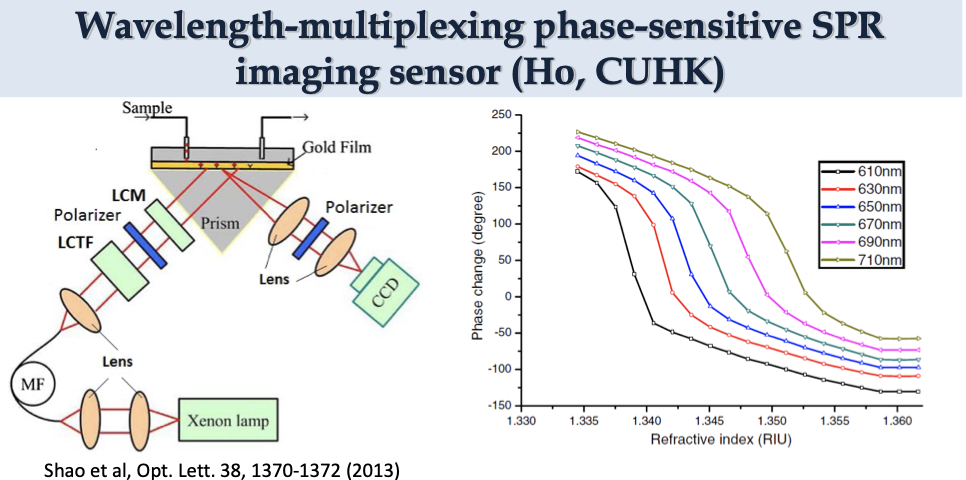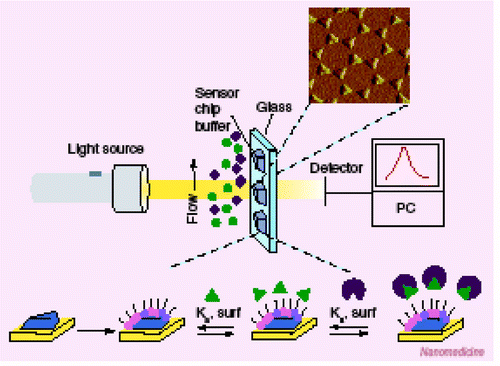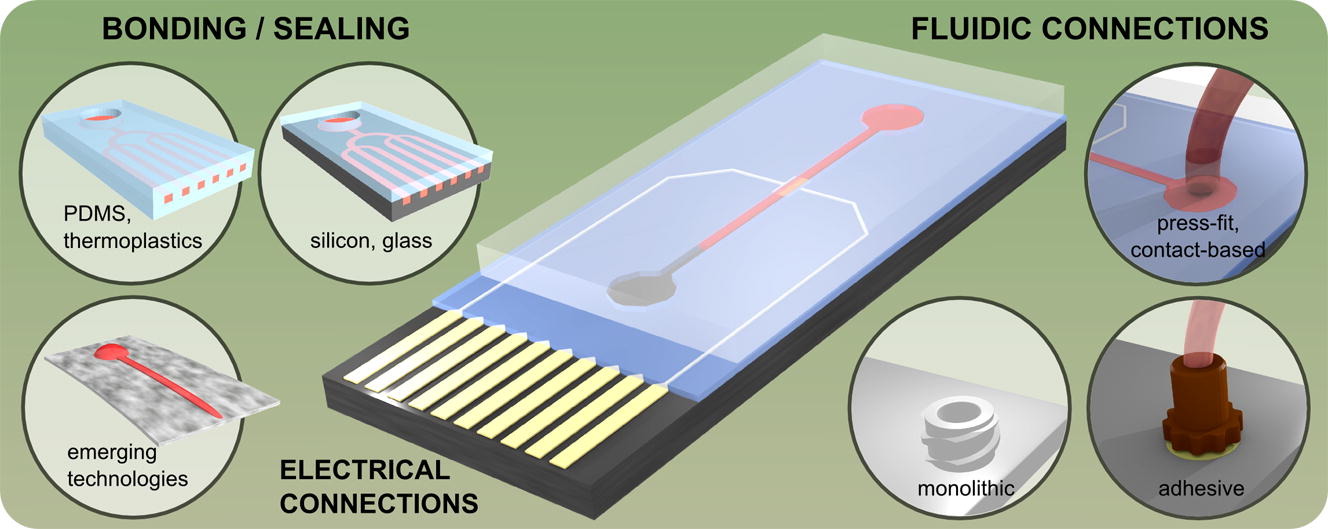
Research Topics
Surface Plasmon Resonance (SPR) Spectroscopy is a technique to detect the local refractive index changes within the proximity of a metal surface. It has become the leading method for label-free detection. SPR sensors available today are based on spectral, angular, and phase detections.
For spectral and angular SPR, the change in surface plasmon polariton (SPP) in response to the changes in refractive index, resonant wavelength shift or angle can be used as a signature for detecting the presence of the target analytes by scanning either the wavelength at a fixed angle or the angle at a fixed wavelength. On the other hand, phase-based SPR relies on measuring the phase difference between p- and s-outgoing fields to determine the refractive index change.
Working principle:
SPR sensors are based on an optical phenomenon. The collective coherent oscillations of free electrons in the conduction band of metal are first excited by the interactive electromagnetic field at a metal/dielectric interface and create charge density oscillations known as surface plasmon polaritons (SPPs).
Two main types of SPR sensors:
Propagating SPR (PSPR) sensors:

Principle of Propogating SPR sensors
Localized SPR (LSPR) sensors:


J. Zhao, X.Y. Zhang, et al., Localized surface plasmon resonance biosensors.
Principle of Localized SPR sensors
LSPR Sensor
The main challenge for all electrical, mechanical and optical sensors is to detect low molecular weight (less than 400 Da) chemical and biological analytes under extremely dilute conditions. Surface plasmon resonance sensors are the most commonly used optical sensors due to their unique ability for real-time monitoring the molecular binding events. However, their sensitivities are insufficient to detect trace amounts of small molecular weight molecules such as cancer biomarkers, hormones, antibiotics, insecticides, and explosive materials for early-stage disease diagnosis, food quality control, environmental monitoring, and homeland security protection. With the development of advanced nanotechnology, nanomaterials-enhanced SPR sensors have been developed and used as effective tools to sense molecules up to amol concentration.
Recent Developments:
Functionalized magnetic nanoparticles (MNPs) like the Fe3O4 nanoparticles have been developed for signal amplification. Advantages of using MNPs are that the lower cost of production and the step for initial receptor immobilization onto the SPR sensing film is not needed. Graphene-modified SPR sensing substrates are coated with graphene layers on gold or silver thin films to induce larger SPR signal changes compared to those with bare-metal thin films. It is used to detect highly selective adsorption of aromatic ring structure molecules (e.g., DNA and TNT).
Reference:
[1] Appl. Phys. Lett. 104, 171116 (2014)
[2] Chem. Soc. Rev., 2014, 43, 3426
Lab-on-a-chip (LOAC):
A compact device of several square centimetres in size that brings several laboratory operations in one microarray for various biomedical applications, such as allergy testing.

Y. Temiz, R.D. Lovchik, G.V. Kaigala, E. Delamarche, Lab-on-a-chip devices: How to close and plug the lab?, Microelectronic Engineering, Volume 132, 2015, Pages 156-175, ISSN 0167-9317, https://doi.org/10.1016/j.mee.2014.10.013.
A Lab-on-a-Chip system
Lab-on-a-disc (LOAD):
Lab-on-a-disc, or the centrifugal microfluidics platform, is a recent variant of Lab-on-a-Chip. LOAD is a microfluidic disc device with chambers, valves and channels that integrates laboratory operations in one platform using centrifugal, inertial and Coriolis forces generated due to rotational motion.
Recently, we have developed a LOAD system for allergy testing. Our disc design has a diameter of 10 cm and contains four identical units for testing allergens. The channels (500-μm width and 250-μm depth) and chambers are made of polydimethylsiloxane moulded with a SU-8 master made from photolithography; the siphon valve region is modified with titanium dioxide. The polydimethylsiloxane layer is attached to a flat polymethylmethacrylate (PMMA) disc. This disposable LOAD platform integrates reagent metering, mixing, reaction, analyte selection and signal generation and detection in an automated fashion.
Lab-on-a-Disc: Uses and Benefits

Y.Y. Wang, S.Y. Liu, W.Y. Zhang, Y.Y. Wei, J.X. yang, S.D. Zhu, SmartDisc: A power-enabled Lab-on-a-Disc platform for Bioassays.
A Lab-on-a-Disc system

Y.Y. Wang, S.Y. Liu, W.Y. Zhang, Y.Y. Wei, J.X. yang, S.D. Zhu, SmartDisc: A power-enabled Lab-on-a-Disc platform for Bioassays.
Cell based and droplet based LOAD
Reference:
[3] Bioanalysis (2014) 6(14)